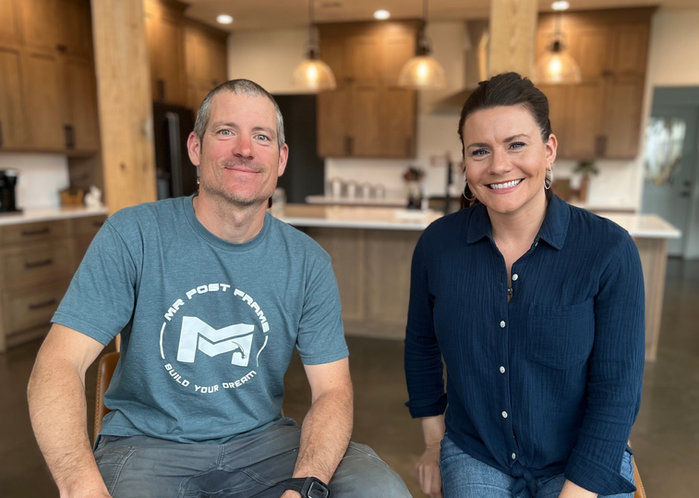This part three of our 30 x 40 post frame garage install. So far we have drilled and poured our piers, placed our brackets, and framed our structure. We can now focus on the trim, metal, and windows.
Next, we can install the "F" channel on all sides. So, I snapped chalk lines and blocked in the ends. I just cut an angle and blocked that in which can be trimmed out later. So, my soffit will run all the way and stop right before the corner. Then the other piece of soffit will go up at an angle from the corner. The only part you will see is the little wooden triangle because the corner trim will cover everything else. To cover the triangle, you can bend a piece of black metal that matches the steel and soffit.

I've snapped a chalk line along the edge to put up the "F" channel. All I have to do is staple it on and then I'm ready for soffit. Once we get all the soffit and fascia on, we'll square up the roof. I think it's pretty good, but we're going to check it anyway.
To handle screwing in the ridge cap across staggered purlins, we just add another block along the truss, butt the purlins together, and then add a splice to ensure it's sturdy. That way, we have a continuous straight purlin on both sides to screw the ridge cap into. The purlin's height depends on the size of the ridge cap you are using. I'm eight inches down from the peak for the ridge cap I'm using. You'll have to adjust it according to your ridge cap size.
Another thing I do is to ensure my fascia boards meet instead of just screwing them in with a three-quarter-inch overlap. I use two-by-fours to provide additional stability. This gives me confidence that the fascia board is securely fastened.

We installed all the "F" channels around the entire building. I squared the roof, and I used 11,000-pound two-inch toe straps. They work well for me. If you need to move the building, you can reuse the ratchet strap. It was pretty windy, but I forgot to cut the tops of these posts, so I need to do that. Then, I'll unbury the steel.
We then get the door framed in. We've got our grade board, which marks the height of the concrete. The door will sit right across it, resting on the concrete. We've also blocked in a two-inch treated piece to protect against contact with concrete. The door is secured across four girts, providing strength. We'll add flashing over it before the door installation.

Then we need to frame in the four windows. The window boxes are already made, and we can just proceed to install them. I cut them to about 41.5 inches. We've got our grade board for the concrete's height, a one-inch bottom trim, 36 inches to the Wayne's coat trim, and a two-by-six to support the window box temporarily. This method allows us to add metal underneath and provides a stable structure for framing.
The next step is to wrap the entire garage and then install the metal cladding on the exterior. I love the black and white color combination. We chose to do the metal cladding one side at a time. and we trimmed out all the doors, and the L8 trim with hem trim adds a nice touch. We install the windows prior to completeing the metal.

We completed the all four sides, and the doors are all trimmed out. We've added weather seals for the garage doors, and we have once installed. We'll need to come back in warmer weather to prepare for in-floor heating and concrete, so the other two garage doors will wait till that is finished.
I also used color-matched aluminum to go below grade, providing a nice finish to the building.
Thank you,
MR Post Frame

Patreon Group:
Interested in tackling your build on your own? If you want to explore the possibility of being your GC or self-building, our Patreon membership is for you! It's a community of like-minded people offering support, discounts, Q/A, and more.